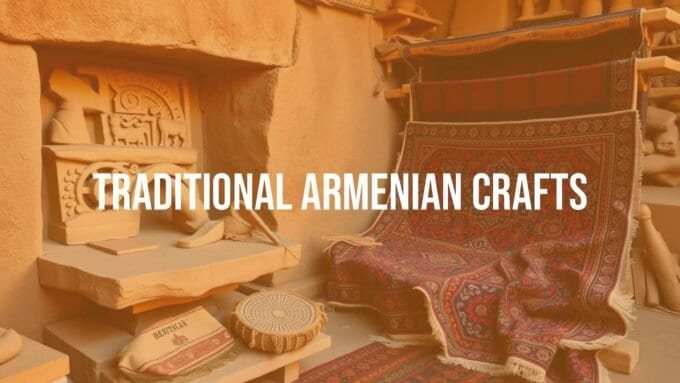Armenian medieval architecture is a striking mix of skill, faith, and endurance. It stands apart in global history. Its roots lie in a land shaken by earthquakes, rich in stone, and shaped by Armenia’s early adoption of Christianity in 301 CE. These factors led to strong yet graceful buildings, mainly churches and monasteries, which served as places of worship and also as centers of culture and identity through long periods of political change.
This tradition combines sound engineering with deep spiritual meaning. While many neighbors built with wood or brick, Armenian builders relied almost entirely on stone. They mastered volcanic tuff and basalt, and this choice shaped many design solutions across the Armenian Highlands. The results are impressive feats of engineering and clear statements of a people who “spoke” through stone, standing against both time and earthquakes.
Distinctive characteristics of Armenian medieval buildings
Armenian medieval buildings show a clear set of features. The most famous is the pointed, conical dome, often compared to Mount Ararat’s cone. These domes, sometimes divided into radial segments, rise over vaulted ceilings on a cylindrical drum, which may appear polygonal from the outside. The dome is not just decoration; it is a smart structural system for its time.
Another key trait is vertical emphasis. Many churches are taller than they are long, and tall, narrow windows draw the eye upward. Stone vaults are everywhere, due to the lack of wood in medieval Armenia. The stones themselves-mainly tuff or basalt-set the look. Tuff ranges in color from pink to black, letting builders create striking visual effects, either in one color or with striped or checkerboard patterns. A type of “concrete” made of lime mortar, broken tuff, and rocks creates a strong core that helps these buildings stand up to earthquakes. Also, frescoes and carvings-often with grapevines and leaves-add rich detail and meaning.

Influences from regional and historical contexts
Armenian medieval architecture did not grow in isolation. It absorbed ideas from nearby cultures while keeping its own voice. At the crossroads of empires, Armenia interacted with Byzantine, Persian, and later Islamic traditions. Frequent changes in rulers left a mark on its building style.
Early basilicas shared features with Syrian churches, showing a flow of ideas from the south. Some Armenian churches, like the Church of the Holy Apostles in Ani, display geometric stonework similar to what is seen in mosques, reflecting Islamic influence. Muqarnas-like geometric vaulting also appears in certain church interiors. Yet these were not simple copies. Armenian builders blended outside elements with local methods and beliefs, keeping a clear national style. The steady focus on strong, quake-resistant construction reflects the hard realities of building in a seismic land and pushed local innovation forward.
Historical development of Armenian medieval architecture
The story of Armenian medieval architecture shows steady creativity and resilience across several stages that mirror Armenia’s history. From the early Christian centuries, to times of revival and growth, and through periods of hardship and diaspora, Armenian builders refined their craft and left a long-lasting legacy in stone.
Formative periods: 4th-7th centuries
The 4th to 7th centuries are often called a golden age. Armenia adopted Christianity in 301 CE, a major turning point that directed building toward churches and monasteries. Early churches were often simple basilicas, sometimes with side apses. Etchmiadzin Cathedral, founded in 303 CE, is the oldest cathedral in the world and marks the start of this new path.
By the 5th century, the cone over the cupola appears widely, leading to the famous domed forms. The 7th century brought centrally planned churches and new ideas, such as the niched buttress and the radiating Hripsimé type. Saint Hripsime (618 CE) and Saint Gayane (630 CE) show this shift, with advanced designs that shaped later work. This era, just before the Arab invasion in the mid-7th century, set the core elements of classical Armenian architecture under the pressure of all-stone building in a quake-prone region.
Bagratid revival: 9th-11th centuries
After a slowdown following the Arab invasion, a strong revival came under the Bagratid dynasty (9th-11th centuries). Builders studied earlier monuments to regain lost skills, then pushed forward with new projects, especially around Lake Van. Traditional forms returned and new ideas appeared side by side.
Many cities and churches rose in this period, including a new capital at Lake Van and the Cathedral of Ani (completed 989-1001). Major monastic centers emerged, such as Sanahin (957-966) and Haghpat (976-991), which became key places of learning and culture. Khachkars-finely carved cross-stones-also developed into powerful national symbols. This creative wave ended with the Seljuk invasion, which closed this chapter of building activity.
Flourishing of monasteries: 12th-14th centuries
From the 12th to the 14th centuries, many monasteries were built or expanded, often under the Zakarid princes. Greater security allowed these complexes to grow. Monasteries served as religious centers, schools, cultural hubs, and shelters during conflict. Many important works of literature were written there.
Key sites include Gandzasar (1216-1238), Kecharis (begun 1033, with later work), Goshavank (1191-1196), and Makaravank (main church 1205). These often included multiple churches, chapels, tombs, and gavit (narthex) halls, forming plans suited to monastic life. Noble families supported this activity. The era closed with the invasions of Timurlane and the fall of Cilician Armenia in 1375, which halted progress for about 250 years.
Kingdom of Cilicia and later changes
The Armenian Kingdom of Cilicia (1080-1375), founded by Armenians fleeing the Seljuk advance, grew along the Mediterranean and often allied with European Crusaders. Its location and ties brought clear outside influence, especially in fortifications.
Cilician castles, like Corycus and Yılankale, show Crusader-style defenses against siege warfare. While military needs took center stage in Cilicia, Armenian identity stayed strong, blending local and foreign methods. After Cilicia fell, and after a quiet period in Greater Armenia, a national revival came under the Iranian Safavids in the 17th century. Builders raised new churches at long-used holy places, such as Etchmiadzin, and in diaspora centers like New Julfa in Isfahan. Many older sites were repaired or enlarged. New styles in Armenia itself slowed after the 17th century, but Armenian forms continued to grow in diaspora cities, showing the lasting energy of Armenian builders.
Core elements and construction methods
The strength and look of Armenian medieval buildings come from smart choices of materials and clever techniques. In a land with frequent quakes and limited wood, builders shaped an approach that kept their churches and monasteries standing for centuries.
Materials commonly used in Armenian medieval structures
Local geology set the palette. Armenia has plenty of stone and few forests, so major buildings were made of stone. Volcanic tuff was the main material. It is light and easy to carve, and it hardens over time in air, which makes it especially useful.
Tuff comes in many colors-pink, red, orange, and black-and builders used this to create different effects. Some buildings are all one color with blocks cut so finely that mortar is barely seen. Others use contrasting colors for stripes or checkerboards. Dark basalt often supports foundations and other areas needing more strength. Unlike many Romans or Syrians of the same ages, Armenians stayed with stone for large structures. That choice shaped both the style and the life span of their buildings.
| Material | Source/Type | Main traits | Typical use |
|---|---|---|---|
| Tuff | Volcanic, porous | Light, easy to carve, hardens with time, varied colors | Walls, domes, carvings, facades |
| Basalt | Dense volcanic rock | Very strong, dark color | Foundations, load-bearing parts |
| Lime mortar mix | Mortar with broken tuff and rocks | Sets into a hard core | Structural cores in walls and domes |
Architectural techniques and innovations
Armenian builders developed effective methods for stone buildings in a seismic zone. A key technique used a kind of concrete made from lime mortar, broken tuff (often larger pieces), and rocks. Thin tuff slabs were set like brickwork to form parallel faces. The wet mortar mix was poured between them. As it dried, the slabs bonded to the core, which became very hard over time.
The result was a solid mass, similar to modern concrete, that could carry heavy vaults and domes and handle side-to-side movement during quakes. Early churches had little or no core, with stones sealed together, but as builders saw how well the mortar core worked, they made it larger and more central to the design. To reduce weight in domes, they sometimes used lighter tuff or large terracotta jars inside the core. Careful work on exterior tuff walls also helped: beveled slabs and varied sizes improved surface bonding and quake resistance while adding visual depth.
Symbolism and decorative features
These buildings carry rich meaning in their forms and details. The pointed dome is more than an engineering choice; it also points upward like a prayer, echoing Mount Ararat. Tall, narrow windows and strong vertical lines add to this upward pull.
Decoration was often simple inside older churches to keep attention on ceremonies, but later periods and exteriors show more detail. Frescoes and stone carvings feature grapevines and leaves-motifs tied to ancient traditions and symbols of life. Khachkars (cross-stones) are especially unique. Each one is different, but all share a common layout, with a cross and intricate floral and geometric patterns. They mark graves, guide rituals, and express belief. Builders also played with the colors of tuff, turning facades into quiet but powerful works of art filled with cultural meaning.
Types of Armenian medieval buildings
Armenian medieval architecture includes many building types, each carefully made for a clear purpose while sharing a national style. From large cathedrals to remote monasteries and strong fortresses, they reveal the era’s faith, defense needs, and daily life.
Church architecture: plans and variations
The story of Armenian architecture is largely a story of church design. After conversion to Christianity, building activity expanded quickly. Early churches were often three-aisled basilicas, sometimes with side apses, as seen at Ererouk and Kasagh. A simpler one-aisle hall church also spread across the land.
As ambitions grew, builders favored domes. Basilicas such as Tekor gained domes over their central bays by the late 5th or early 6th century. Soon, fully centralized domed plans appeared in many forms. The cruciform plan, shaped like a Greek cross from the outside, became common and often carried a central dome. Variants include the “niche-buttressed square,” where four apses push out from the middle of each wall to carry the dome’s weight (as at Etchmiadzin). The “radiating plan” of Saint Hripsime is seen as distinctly Armenian, with an interior tetraconch (four semi-circular apses) and deep niches lifting a high drum and dome. The most complete circular plan appeared at Zvartnots, with an aisled tetraconch refined into a near-perfect ring.
Monasteries and their complex layouts
Monasteries were central to medieval Armenian life. They were religious houses, schools, cultural centers, and sometimes safe places during war. A monastery was rarely a single building. It was a compound with multiple churches and chapels, refectories, libraries, living quarters, and often protective walls.
From the 9th to 14th centuries, especially in the Bagratid and Zakarid periods, many monasteries rose or grew. Haghpat and Sanahin (both UNESCO sites), as well as Tatev, Geghard, and Noravank, are major examples. Many include gavits-large square halls on the west side of churches-used for meetings, as vestibules, and sometimes as burial places. Roofs of gavits often rest on intersecting arches with a central opening for light. These layouts show how monasteries supported worship, learning, manuscript work, and community refuge.
Fortresses and defensive architecture
Given Armenia’s history and position on key routes, defenses were very important. Fortresses, castles, and walled settlements protected lands and towns. While many early sites are gone, the medieval period left many strongholds.
Amberd (7th century with later work), Bjni, and Smbataberd show the strength of Armenian fortification. Thick stone walls, towers, and high ground placements provided strong defense. In Cilicia (1080-1375), military design advanced, influenced by European Crusader castles. Places like Corycus used features built to resist pre-gunpowder sieges. These sites often had inner areas with homes, churches, and support buildings, forming self-sufficient centers during war.
Vernacular dwellings and auxiliary structures
While great churches and forts dominate the record, daily homes and smaller buildings show important traditions too. Few early houses survive because many were made of wood, mud brick, or cut into the ground. Archaeology and later examples give us clues.
In Syunik, people built carved cave homes, often with decorated entrances. These caves, sometimes sheltering 12-25 people, were linked by ropes, ladders, and narrow paths-smart answers to terrain and defense needs. You can still see them in older parts of Khot, Khndzoresk, and Goris. Other local styles appear in Dilijan, with one- or two-story houses made of uncut gray basalt and sandy limestone, rounded arches, and high gabled roofs to shed heavy rain and snow. In Yerevan, the Kond district once had simple wooden balconies, tight lanes, and terraced homes on steep slopes. These varied forms show how builders made useful, culturally rich homes that fit local settings.
Notable examples of Armenian medieval architecture
Across Armenia, many remarkable medieval sites stand out, mostly churches and monasteries that tell stories of faith and skill. They are living pieces of heritage that continue to move and inspire. Below are some defining examples.
Etchmiadzin Cathedral
Etchmiadzin Cathedral in Vagharshapat is known as the world’s oldest cathedral, begun in 301 CE under King Tiridates III, when Armenia adopted Christianity. The core of the building comes from that early phase, but it saw many changes, including major work in the 7th and 17th centuries and a belltower added in 1658.
Etchmiadzin is a clear example of the “niche-buttressed square” plan, which carries the dome’s weight very well. Unlike many early Armenian churches, its interior is richly painted with colorful geometric designs influenced by later styles, including Islamic art. As the mother church of the Armenian Apostolic Church and a UNESCO site, it remains a powerful symbol for Armenians worldwide.
Saint Hripsime and Saint Gayane Churches
Also in Vagharshapat, Saint Hripsime (618 CE) and Saint Gayane (630 CE) are fine early medieval churches, both on the UNESCO list. Saint Hripsime shows the “radiating plan” that many consider distinctly Armenian. Inside, a tetraconch with deep niches supports a high drum and dome. The heavy outer walls reveal the inner form through triangular slits, showing advanced handling of mass and space. Its design became a model across Armenia and the Caucasus.
Saint Gayane is a domed basilica built on a site linked to a 4th-century martyr. Made of local volcanic stone with a pink or orange tone, it carries a central dome on four free-standing pillars. The dark stonework inside creates a calm mood, with soft daylight shaping the space. Both churches remain sacred sites and key works of Armenian art and building.
Zvartnots Cathedral
The ruins of Zvartnots, near Vagharshapat, show Armenia’s bold vision in the 7th century. Built between 641 and 652 by Catholicos Nerses III, it was a circular aisled tetraconch of great size. The domed four-lobed interior likely reached about forty meters in height, with a diameter to match. Its thirty-two-sided form represents the peak of the circular centralized plan.
At a time when much of Europe lagged, Zvartnots stood out for its scale and design. A ring of columns led into the center through open passages. The church collapsed in the 10th century; experts still debate whether a quake or raids caused it. Even as ruins, it holds a strong place in Armenian memory. Its plan influenced later buildings in Georgia and Armenia, including the lost Gagikashen at Ani. The site is a UNESCO World Heritage Site.
Geghard Monastery
High in the mountains, Geghard is one of Armenia’s most remarkable monasteries and a UNESCO site. Monks settled there by the 4th century, but the main church dates to 1215, with many later additions. Much of the complex is cut directly into the rock, including chapels and tombs, which blend with the free-standing buildings to form a unified whole.
Stone carving inside the rock-cut spaces is especially fine. Geghard drew pilgrims for centuries and was said to keep holy relics, including the spear (geghard) that pierced Christ, which gave the site its name. Its secluded setting and bold rock-cut work make it a strong image of Armenian faith and building skill.

Sanahin and Haghpat Monasteries
Sanahin and Haghpat, both in Lori province and on the UNESCO list, offer major examples of 10th-13th century monastic building under the Bagratids and Zakarids. They share key traits: cruciform plans, central domes with conical roofs, and thick stone walls of dark volcanic rock.
Haghpat’s main church (976-991) has a large gavit (c. 1210) with a dome carried by intersecting arches and squat columns. It also preserves vivid frescoes in a Byzantine style, rare in Armenian churches. Sanahin (957-966) holds a tight group of churches, chapels, and gavits, with narrow windows like arrow slits, a reminder of uncertain times. Both sites are known for finely carved khachkars and their high views over the Debed River canyon.
Tatev Monastery
Tatev, in Syunik, sits on a cliff above a wide valley. Founded between 895 and 906, its remote location fit the monks’ wish to live away from towns. The main church has a large dome topped by a geometric conical roof of triangular facets, a classic Armenian way to shed snow and create a sharp skyline.
Tatev is a wide complex with several buildings, protective walls, and a unique swinging bell tower. It was an active center of learning and worship, with a university and scriptorium. Today, visitors reach it by the “Wings of Tatev” aerial tramway, one of the longest of its kind, which makes it easier to visit this major site.
Ruins of Ani
The ruins of Ani sit in present-day Turkey near the border with Armenia. Known as “the city of 1001 churches,” Ani was the Bagratid capital and thrived from the 9th to the 11th centuries on trade routes linking East and West. Its wealth showed in its walls, churches, and public buildings.
The Cathedral of Ani (989-1001) and the Church of the Holy Redeemer (1035) still hint at the city’s former greatness. The Cathedral is a domed basilica that shows the high level reached in the Bagratid era. The Holy Redeemer has rich geometric stonework with Islamic flavor mixed into Armenian design. The Mongol sack of 1236 led to decline and abandonment. Today Ani is a UNESCO World Heritage Site, keeping alive the memory of a major Armenian city.
Armenian medieval architecture outside modern Armenia
Armenian medieval architecture stretches far beyond today’s borders. This reflects both the wide reach of the Armenian Highlands in the past and the lasting work of Armenian communities over time. Many key sites lie in nearby countries, and diaspora communities have carried the style around the globe.
Architectural heritage in Turkey, Iran, and Azerbaijan
Due to shifting borders and population changes, many Armenian sites lie in present-day Turkey, Iran, and Azerbaijan. In Turkey, Ani stands out, with the Cathedral of Ani, the Church of the Holy Redeemer, and St Gregory of the Abughamrents among its major monuments (all within a UNESCO site). Other highlights include Khtzkonk’ Monastery in Kars and the Church of the Holy Cross on Akhtamar Island in Lake Van, a striking 10th-century work under the Artsruni lords.
In Iran, Armenian monastic groups are especially important. St. Thaddeus Monastery (13th-14th centuries, rebuilt in the 19th) follows the plan of Etchmiadzin. Saint Stepanos and the Chapel of Dzordzor are also on the UNESCO list, showing the long presence of Armenians there. In Azerbaijan, Gandzasar Monastery (1216-1238) near Vank is a major 13th-century site from troubled times. These places, often in historic Armenian areas, link shared history across the region.
Spread and adaptation in the Armenian diaspora
Armenian communities across the world kept their building traditions alive. To hold on to their identity, they built churches and centers that echo famous monuments from the homeland. Designs inspired by Ani, Zvartnots, and Etchmiadzin appear in many countries.
The Armenian Cathedral of Lviv (1363-1370) shows this reach in Eastern Europe. In recent times, as communities grew in the Americas and Australia, the pattern continued. The Armenian Cathedral of Moscow (2013) draws on medieval Armenian forms in a modern setting. Beyond churches, khachkars have become visible signs of identity in cities from Wrocław and Kraków to Beirut and Dearborn, Michigan. This spread shows how Armenian medieval architecture keeps shaping new places and generations.
Preservation and recognition of Armenian medieval monuments
These monuments are more than old stones; they carry history, faith, and culture. Protecting them matters for keeping a unique chapter of human building alive. Efforts range from global recognition to local action, but many hurdles remain.
UNESCO World Heritage Sites
UNESCO status has helped bring worldwide attention to Armenian medieval architecture and has supported protection work. Several key sites inside Armenia are on this list, showing their value for all people. The Cathedral and Churches of Echmiatsin (Etchmiadzin, Saint Hripsime, Saint Gayane, and Shoghakat) and the Archaeological Site of Zvartnots form one group in Vagharshapat, marking the roots of Armenian Christianity and early building advances.
The Monasteries of Haghpat and Sanahin are also listed for their outstanding religious buildings from the Bagratid era. Geghard, with its rock-cut spaces and fine carvings, completes the group inside Armenia. Beyond current borders, the site of Ani in Turkey and the Armenian Monastic Ensembles of Iran (St. Thaddeus, Saint Stepanos, Chapel of Dzordzor, and Chapel of Chupan) also hold UNESCO status.
| UNESCO site | Location | Main features |
|---|---|---|
| Etchmiadzin & Zvartnots | Vagharshapat, Armenia | Early cathedrals, niche-buttressed plans, circular aisled tetraconch |
| Haghpat & Sanahin | Lori, Armenia | Monastic complexes with gavits, khachkars, scholarly centers |
| Geghard | Kotayk, Armenia | Rock-cut churches, fine stone carving |
| Ani | Kars, Turkey | Capital ruins with cathedrals and city walls |
| Armenian Monastic Ensembles | NW Iran | St. Thaddeus, St. Stepanos, Dzordzor, Chupan chapels |
Challenges to conservation and risks of devastation
Many threats endanger these buildings. Armenia lies in a quake zone, and even though medieval builders planned for this, many tremors over centuries cause damage. Weather and time also wear down stone and mortar, calling for steady repair.
An even harder problem is deliberate damage or neglect linked to anti-Armenian policies in some neighboring states. Reports point to efforts to erase Armenian traces in places like Azerbaijan and Turkey. The loss at Old Jugha in Nakhichevan is especially painful: the largest collection of khachkars was destroyed in 2005, with photos and later satellite images showing the graveyard replaced by a military training ground. Inside Armenia, fast urban growth and lack of care also threaten older districts, as seen in parts of Yerevan. Ongoing watchfulness, global support, and steady funding are needed to protect these sites from both nature and human actions.
Legacy and impact of Armenian medieval architecture
Armenian medieval architecture has a wide and lasting impact. It shaped nearby styles and still carries deep cultural and religious meaning. It stands as clear evidence of a people’s faith, art, and strength through many hard centuries.
Influence on regional architectural styles
During its early and high periods, Armenian church design influenced building across the Caucasus. Plans like the radiating Hripsimé type and the many domed solutions inspired work in Georgia and beyond. The skilled use of stone, the engineering of domes and vaults, and the conical roofs spread through neighboring traditions.
Many scholars see Armenian church design as one of the first national styles in Christian architecture, formed before Byzantine, Romanesque, or Gothic took final shape. Its stone-and-dome solutions for earthquake country affected how others built. Decoration and the upward feel of the structures also echoed in many Eastern Christian churches.
Cultural and religious significance today
Today, Armenian medieval churches and monasteries are active places of worship, pilgrimage, and national identity. They link people to their faith and their homeland.
Their survival over a thousand years gives a strong sense of continuity. Modern Armenian buildings often borrow elements like conical domes and tuff facades, keeping the line unbroken. The global Armenian community helps preserve old sites, builds new churches in the same spirit, and raises khachkars as shared symbols. Armenian medieval architecture remains living heritage, shaping culture and faith in Armenia and across the world.















Leave a comment